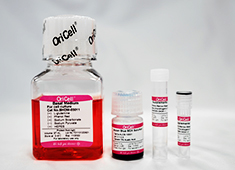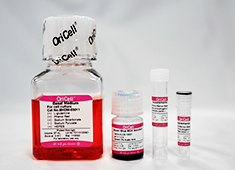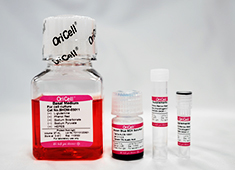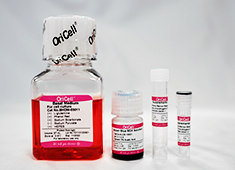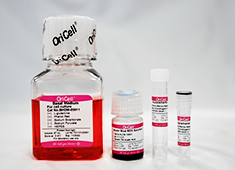OriCell™ Chondrogenic Differentiation Medium For Mouse Bone Marrow Mesenchymal Stem Cells
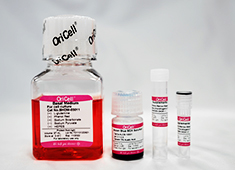
Introduction
OriCell™ Chondrogenic Differentiation Medium For Mouse Bone Marrow Mesenchymal Stem Cells, carefully developed by the OriCell™ R&D team, contains a basic medium and various additives which were suitable for the growth of mouse bone marrow mesenchymal stem cells. Extensive cell culture data have demonstrated that this product can stably and efficiently induce the above-mentioned cells to differentiate into cartilage tissue.
When citing our products in academic journals, please indicate “OriCell™ + Catalog Number, from Cyagen Biosciences(Guangzhou)Inc.”
Product Information
| Components | Catalog Number | Volume |
| OriCell™ Basal Medium For Cell Culture | BHDM-03011 | 97 mL |
| OriCell™ Supplements For Mouse Bone Marrow Mesenchymal Stem Cells Chondrogenic Differentiation I | MUXMX-04041-1 | 2 mL |
| OriCell™ Supplements For Mouse Bone Marrow Mesenchymal Stem Cells Chondrogenic Differentiation II | MUXMX-04041-2 | 1 mL |
| OriCell™ Alcian Blue 8GX Solution (pH=2.2) | ALCB-10001 | 5 mL |
QC
- Pass the detection of bacteria, fungi, mycoplasma and endotoxins.
- Pass the detection of osmotic pressure and pH.
- Pass the detection of product quality.
Please reference "COA" for details.
General Handing Principles
- Ensure that all equipment is kept clean and tidy.
- Standard operation method. Please operate according to the method described in the product manual.
- The ingredients should be properly stored in accordance with the storage conditions and used as soon as possible.
- If complete medium cannot be used in a short period of time, it should be prepared in batches according to the volume ratio of each component in the kit and stored in aliquots.
Product Stability and Storage Conditions
- All ingredients must be kept in dark place.
- The basal medium should be stored in a refrigerator at 4°C for a period of 1 year. Other components should be stored at -20°C for a period of 2 years.
- The prepared complete medium can be stored at 4°C for a period of 1 month. If the culture conditions are stable, the container has great sealing performance, and there is no alternation of hot and cold condition, the period of using can be appropriately extended, but not exceed 45 days.
- Please use all products within the expiration date. Expired ingredients may significantly affect the cell culture effect.
Preparation of Premix Solution
Materials Required
- OriCell™ Chondrogenic Differentiation Medium For Mouse Bone Marrow Mesenchymal Stem Cells (Cat. No.: MUXMX-90041)
- Clean, sterile, and stable quality disposable consumables (pipettes, pipette tips, centrifuge tubes, etc.)
- Clean sealing film
- Aluminum foil paper and other light-avoiding materials
Steps
- At least 30 minutes before preparation, place OriCell™ Supplements For Mouse Bone Marrow Mesenchymal Stem Cells Chondrogenic Differentiation I (Cat. No.: MUXMX-04041-1) in a refrigerator at 4°C until it is completely melted.
- Turn upside to down or flick the reagent tube to mix the reagent.
- Use 75% medical alcohol to carefully wipe the outer packaging of all ingredients. Open the package in the clean bench.
- Add Cat. No. MUXMX-04041-1 to OriCell™ Basal Medium For Cell Culture (Cat. No. BHDM-03011).
- Take a little amount of basal medium, wash each bottle and tube, and add all the ingredients to the basal medium as much as possible.
- Tighten the cap of the basal medium bottle and shake it gently and thoroughly.
- Seal the bottle with parafilm, wrap the bottle with aluminum foil paper, and mark the name, preparation date and other information.
Special Reminder
- If complete medium will not be used immediately, we recommend preparing in batches. Please prepare the required amount according to the ratio of each component in the kit. Any remaining components must be stored according to their respective storage conditions and should not be subjected to multiple freeze-thaw cycles.
- All components in the OriCell™ Chondrogenic Differentiation Medium For Mouse Bone Marrow Mesenchymal Stem Cells are strictly aseptically controlled. Under normal circumstances, we do not recommend sterilization again. If there is a risk of contamination during the preparation process, the complete medium can be filtered and sterilized.
- The prepared chondrogenic differentiation medium should be aliquoted into small portions to avoid repeated freeze-thaw cycles.
Procedure for Inducing Differentiation
Materials Required
- OriCell™ Chondrogenic Differentiation Medium For Mouse Bone Marrow Mesenchymal Stem Cells (Cat. No.: MUXMX-90041)
- 4% Paraformaldehyde solution or 10% Formalin solution
Steps
- Transfer 3~4×105 cells to a 15 mL centrifuge tube, and centrifuge at 250×g for 4 min at 20°C.
- Aspirate the supernatant. Add 0.5 mL into chondrogenic differentiation premix, resuspend the pellet obtained from the previous centrifugation, and centrifuge at 150×g for 5 min at 20°C.
- Repeat step 2 to wash the cells again.
- Add OriCell™ Supplements For Mouse Bone Marrow Mesenchymal Stem Cells Chondrogenic Differentiation II (Cat. No. MUXMX-04041-2), according to the proportion (add 10 μL Cat. No. MUXMX-04041-2 to 1 mL of chondrogenic differentiation premix). Add the amount of Cat. No. MUXMX-04041-2 to the corresponding volume of premix to prepare a complete chondrogenic differentiation medium, and gently pipette to mix.
Note:
- Centrifuge the reagent tube briefly before sucking Cat. No. MUXMX-04041-2, so that the reagent can be collected at the bottom of the tube for use;
- Be sure to store Cat. No. MUXMX-04041-2 in aliquots below -20°C, avoid repeated freezing and thawing, and can be stored for 12 months;
- The chondrogenic differentiation medium added with Cat. No. MUXMX-04041-2 must be prepared for immediate use, and stored at 4°C for no more than 12 h.
- Resuspend the cell pellet obtained in step 3 in 0.5 mL of chondrogenic differentiation medium, and centrifuge at 150×g for 5 min at 20°C.
- Unscrew the centrifuge tube cap to facilitate gas exchange. Place it upright in a CO2 incubator at 37°C, 5% CO2, and saturated humidity.
Note:1)This step does not need to aspirate the supernatant or resuspend the cells;
2)Do not shake the centrifuge tube within 24 hours.
- When the cell clusters appear clustered (usually after 24 h or 48 h, depending on the actual situation), flick the bottom of the centrifuge tube to make the cartilage ball detach from the bottom of the tube and suspend it in the liquid.
- Calculated from the beginning of inoculation, replace the cells with fresh chondrogenic differentiation medium every 2 to 3 days, about 0.5 mL per tube.
Note:
1)Be careful not to suck out the cartilage ball;
2)After each medium change, you need to flick the centrifuge tube to make the cartilage ball detach from the bottom of the tube and suspend in the liquid;
3)After changing the medium each time, be sure to loosen the cap of the centrifuge tube and put it into the incubator.
- Continue to induce until a cartilage ball with a diameter of 1.5-2 mm is formed in the tube, and then the section can be prepared for staining.
Cartilage Ball Section Staining
Materials Required
- Induced cartilage balls
- 4% Paraformaldehyde solution or 10% Formalin solution
- Anhydrous alcohol, xylene, paraffin wax
- OriCell™ Alcian Blue 8GX Solution (Cat. No.: ALCB-10001)
Steps
Note:This step takes paraffin section staining as an example. If using frozen sections, please follow the instructions for using the microtome.
- Fixed. The induced cartilage balls were washed with 1×PBS, soaked in 4% paraformaldehyde solution (or 10% formalin solution), and fixed for more than 30 minutes.
Note:The fixative solution needs to be prepared for immediate use.
- Dehydration. The fixed cartilage balls are dehydrated with gradient alcohol in the following way, each stage is 30 minutes.
50% alcohol 70% alcohol 80% alcohol 95% alcohol Anhydrous alcohol
Note:
1)Dehydration must be carried out in a covered container to prevent absorbing moisture in the air;
2)Do not soak the cartilage balls in alcohol for too long, as they are easily broken;
3)When changing alcohol, suck out low-concentration alcohol, and then add high-concentration alcohol. Avoiding movement increases the risk of fragmentation of the cartilage ball.
- Transparency. Because alcohol and paraffin wax are not compatible, it needs to pass through xylene after dehydration. The way is as follows:
- Mix xylene and anhydrous alcohol at a volume ratio of 1:1. Soak the cartilage ball in it for 2 hours.
- Soak the cartilage balls in pure xylene for 1.5 hours.
- Replace with new xylene and continue to soak for 1 hour.
Note:
1)Transparency must be carried out in a covered container to prevent absorbing moisture in the air;
2)During the transparent process, if white misty bubbles appear around the cartilage ball, it means that the water has not been removed. It should be put back in the alcohol for dehydration and then transparent.
- Dip wax. In order to remove the transparent agent in the cartilage ball and make the paraffin penetrate into the interior for embedding, a wax treatment is required.
- Mix xylene and paraffin at a volume ratio of 1:1. Soak the cartilage balls and place them in an oven at 40°C for 40 minutes.
- Soak the cartilage balls in pure paraffin and place them in an oven at 55°C for 30 minutes.
Note:1)The wax immersion should be kept at a lower temperature as much as possible, so that the paraffin wax does not solidify;
2)The temperature must be constant, not high and low.
- Embedding. Take out the cartilage ball and place it in the mold. Pour in paraffin and let stand to cool. After the paraffin is fully cooled and formed, take it out and trim the wax block.
- Slicing. Continuous slices, each slice with a thickness of 3 μm.
- Sticky film.The cartilage ball slices were adhered to the glass slide with an adhesive, and dried in an oven at 35°C.
- Dewaxing.
- Soak the slices in pure xylene for 15 minutes, and replace the slices with new xylene for 10 minutes.
- Xylene and anhydrous alcohol are mixed in a volume ratio of 1:1. Soak the slices for 10 minutes.
- Use 95%, 85%, 70%, and 50% alcohol to soak the slices for 10 minutes and dry them.
- Dyeing
- Add Alcian Blue dropwise to the dried sections and stain them at 37°C for 1 h.
- Rinse the slides with tap water for 5 minutes and dry them.
- Observe the staining effect of Alcian Blue under the microscope. The part stained with Alcian Blue shows the internal acid mucopolysaccharide in cartilage tissue.
The Alcian Blue 8GX Solution Staining Effect
Cyagen Biosciences (Guangzhou) Inc. reserves all rights to the technical documents of OriCell™ cell culture products. Without the written permission of Cyagen Biosciences (Guangzhou) Inc. any part of this document shall not be adapted or reprinted for other commercial purposes.
- Implantation of biomaterial as an efficient method to harvest mesenchymal stem cells. 点击索取文献 ››
- MicroRNA-145 Regulates Chondrogenic Differentiation of Mesenchymal Stem Cells by Targeting Sox9. 点击索取文献 ››
- Activation of canonical wnt pathway promotes differentiation of mouse bone marrow-derived MSCs into type II alveolar epithelial cells, confers resistance to oxidative stress, and promotes their migration to injured lung tissue in vitro. 点击索取文献 ››
- Migration of CXCR4 Gene‐Modified Bone Marrow‐Derived Mesenchymal Stem Cells to the Acute Injured Kidney. 点击索取文献 ››
- Allogeneic compact bone-derived mesenchymal stem cell transplantation increases survival of mice exposed to lethal total body irradiation: a potential immunological mechanism. 点击索取文献 ››
- Bone marrow mesenchymal stem cells promote the repair of islets from diabetic mice through paracrine actions. 点击索取文献 ››
- Mesenchymal Stem Cells Promote Diabetic Corneal Epithelial Wound Healing Through TSG-6–Dependent Stem Cell Activation and Macrophage Switch. 点击索取文献 ››
- Intramembranous ossification and endochondral ossification are impaired differently between glucocorticoid-induced osteoporosis and estrogen deficiency-induced osteoporosis. 点击索取文献 ››
- Simultaneous isolation of mesenchymal stem cells and endothelial progenitor cells derived from murine bone marrow. 点击索取文献 ››
- Enhanced alleviation of aGVHD by TGF-β1-modified mesenchymal stem cells in mice through shifting MΦ into M2 phenotype and promoting the differentiation of Treg cells. 点击索取文献 ››
- Exosome-shuttled miR-216a-5p from hypoxic preconditioned mesenchymal stem cells repair traumatic spinal cord injury by shifting microglial M1/M2 polarization. 点击索取文献 ››

